
Global Chief Economist @ Arch Capital Group | ex JPM AIG HUD | Husband to Jamie & Dad to Lando & Grey | No investment advice & views are my own 🦬🇺🇸🇮🇱
11 subscribers
How to get URL link on X (Twitter) App

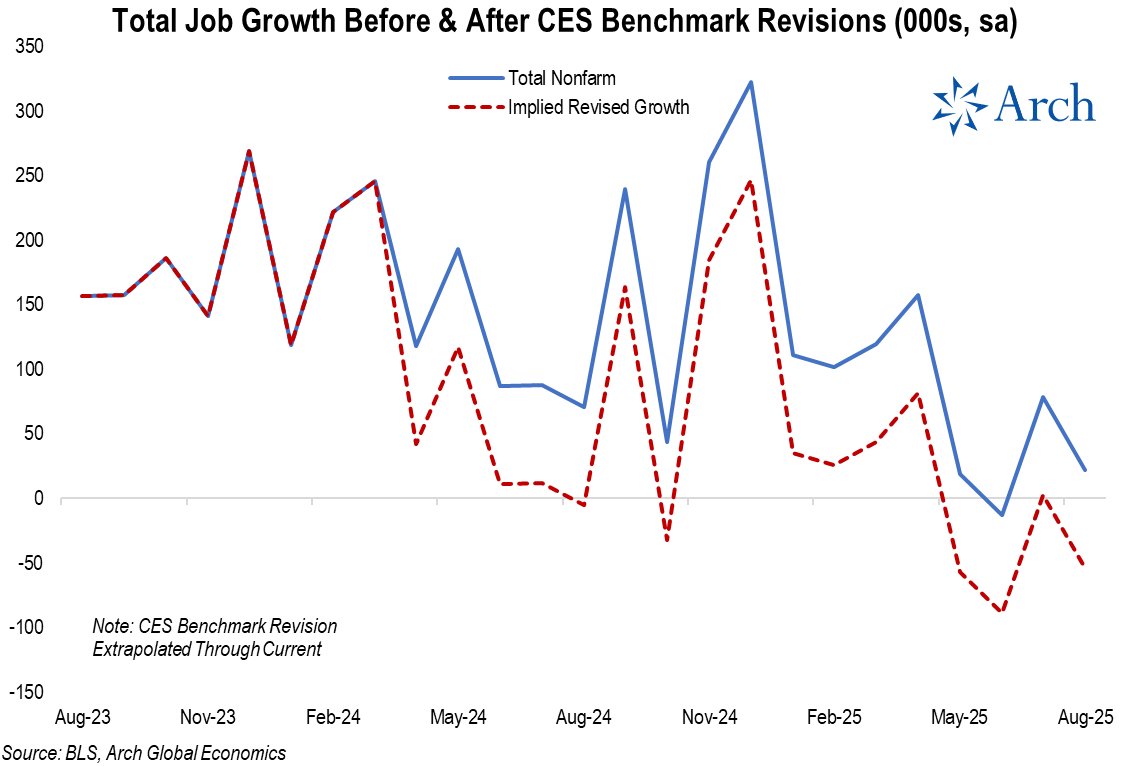
 Here's a look at job growth over the prior 4 months, with sector-level revisions incorporated.
Here's a look at job growth over the prior 4 months, with sector-level revisions incorporated. 
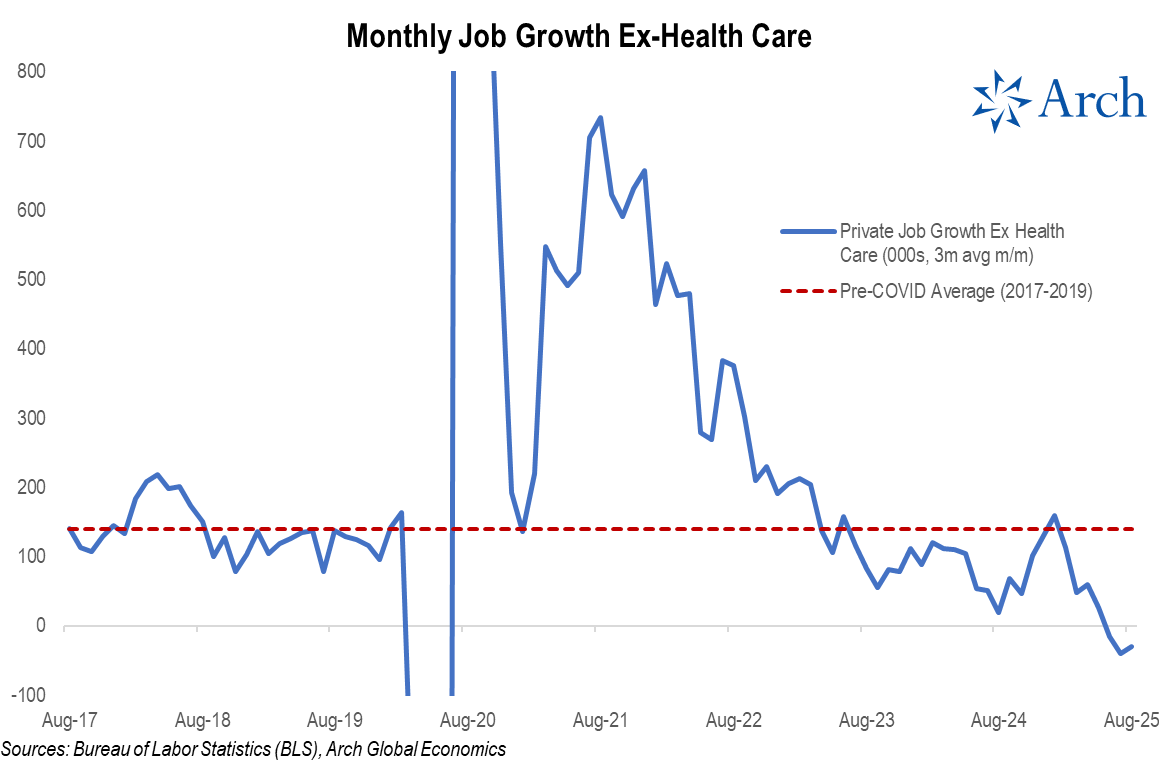
 Here's the same data, but with the breakdown of health care jobs (grey) vs all other industries.
Here's the same data, but with the breakdown of health care jobs (grey) vs all other industries. 

 Let's look under the hood at which regions are driving the recent downshift.
Let's look under the hood at which regions are driving the recent downshift.

 On an absolute basis, announced job cuts were ~44k above normal for August, with most of the lift coming from the east (35.2k above normal), followed by the West (17.1k), with the South and Midwest both below their pre-COVID norm, -3.9k and -4.3k, respectively.
On an absolute basis, announced job cuts were ~44k above normal for August, with most of the lift coming from the east (35.2k above normal), followed by the West (17.1k), with the South and Midwest both below their pre-COVID norm, -3.9k and -4.3k, respectively. 

 My read: although nominal control group growth has remained “solid” in the mid-single digits, real (inflation adjusted) control group growth has cooled notably from robust growth in ’24 (peak of almost 7% q/q saar) to just a 1% quarterly annualized pace in July.
My read: although nominal control group growth has remained “solid” in the mid-single digits, real (inflation adjusted) control group growth has cooled notably from robust growth in ’24 (peak of almost 7% q/q saar) to just a 1% quarterly annualized pace in July.

 There has been a clear rebound in initial claims by federal employees for unemployment insurance, which surged higher in July.
There has been a clear rebound in initial claims by federal employees for unemployment insurance, which surged higher in July.

 The labor force participation rate has dropped from a recent peak of 62.8% back in Nov '23 to 62.2% in July '25.
The labor force participation rate has dropped from a recent peak of 62.8% back in Nov '23 to 62.2% in July '25.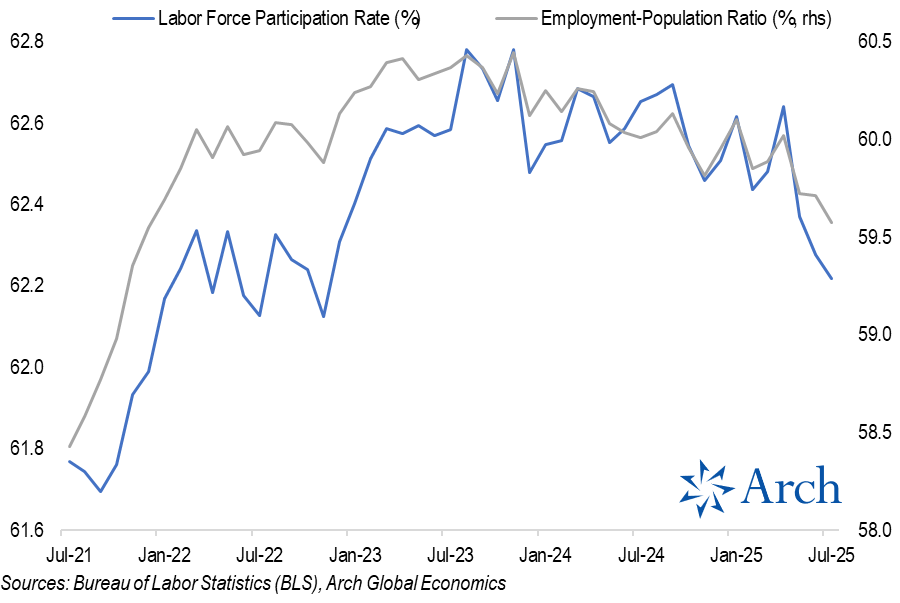
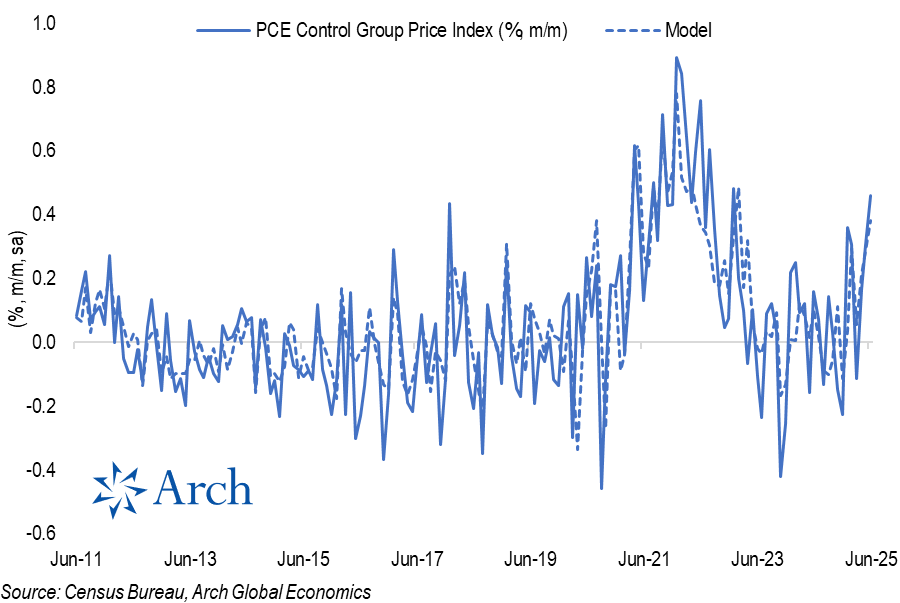
https://twitter.com/Econ_Parker/status/1945849492575518728
 Given the upward revisions to May PCE and modest upside surprise for core inflation, control group inflation accelerated to 0.46% m/m in June, above my 0.38% model estimate and up from 0.31% in May.
Given the upward revisions to May PCE and modest upside surprise for core inflation, control group inflation accelerated to 0.46% m/m in June, above my 0.38% model estimate and up from 0.31% in May.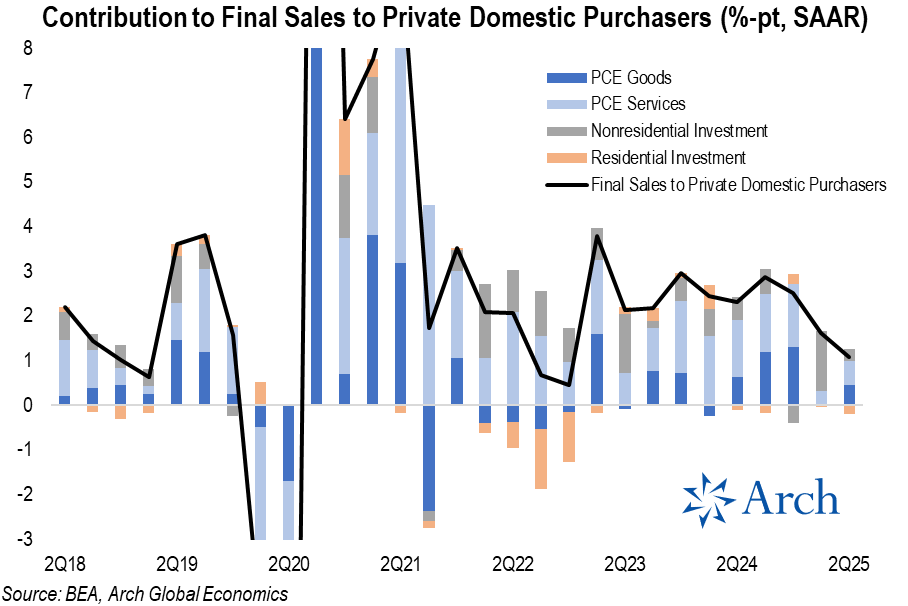
 Headline GDP was flattered by a snap back in net exports as frontloading of imports to get ahead of tariffs in Q1 left a void in Q2.
Headline GDP was flattered by a snap back in net exports as frontloading of imports to get ahead of tariffs in Q1 left a void in Q2.
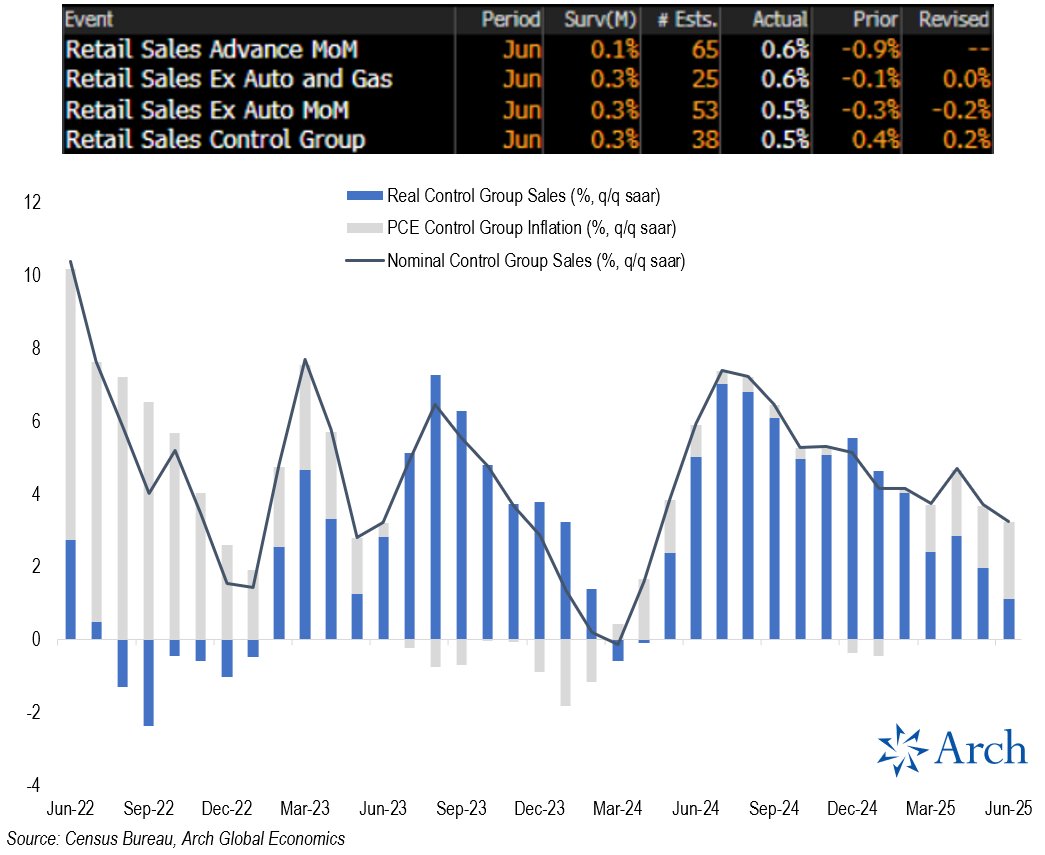
 Here's a look at the simple model I used to estimate the PCE Control Group price index, which leverages CPI and PPI price indexes that correspond to Control Group spending categories like appliances, furniture / furnishing, construction materials, consumer electronics, recreational goods.
Here's a look at the simple model I used to estimate the PCE Control Group price index, which leverages CPI and PPI price indexes that correspond to Control Group spending categories like appliances, furniture / furnishing, construction materials, consumer electronics, recreational goods.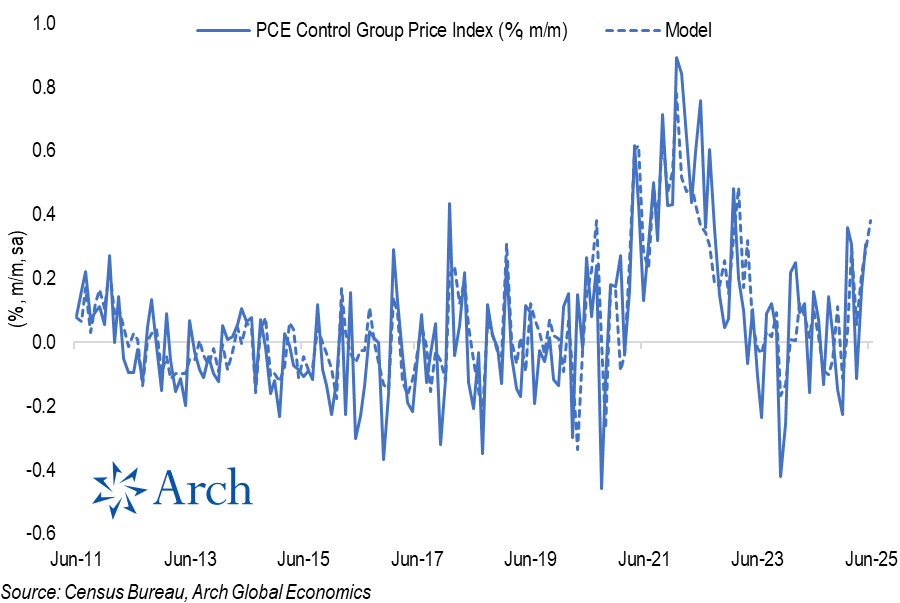

 Looking at the categories flagged as being most exposed to tariffs by two Fed staff economists earlier this year, you'll see a lot of the products in the Household Furnishings & Supplies category on this list 👇
Looking at the categories flagged as being most exposed to tariffs by two Fed staff economists earlier this year, you'll see a lot of the products in the Household Furnishings & Supplies category on this list 👇https://x.com/Econ_Parker/status/1922290381292487033

 As noted at the top, there was a widespread rebound, with consumers' assessment of Current Economic Conditions and Expectations both rising, by a respective 4.8 and 10.5 points.
As noted at the top, there was a widespread rebound, with consumers' assessment of Current Economic Conditions and Expectations both rising, by a respective 4.8 and 10.5 points.

 Two things worth noting before going further:
Two things worth noting before going further:
 First, how can the unemployed population (i.e. continuing claims) rise without a corresponding rise in initial jobless claims?
First, how can the unemployed population (i.e. continuing claims) rise without a corresponding rise in initial jobless claims? 
 Let’s start with the contributions to monthly headline CPI:
Let’s start with the contributions to monthly headline CPI:
 Here's another way of looking at the contribution to monthly personal income growth... a smoothed 3-month average of the contribution.
Here's another way of looking at the contribution to monthly personal income growth... a smoothed 3-month average of the contribution.

 The drag in April came almost entirely from Final Demand for Services (-46bps of the -47bps headline figure), while Core Goods (ex Food & Energy) added 8bps to final demand PPI inflation.
The drag in April came almost entirely from Final Demand for Services (-46bps of the -47bps headline figure), while Core Goods (ex Food & Energy) added 8bps to final demand PPI inflation.
 First, a look at the wider-than-unusual range of estimates from my peers...
First, a look at the wider-than-unusual range of estimates from my peers...


 Here's a look at the 5-year ahead inflation expectations by political affiliation...
Here's a look at the 5-year ahead inflation expectations by political affiliation...

 First of all, the PCE and CPI are constructed differently and measure some of the same categories differently.
First of all, the PCE and CPI are constructed differently and measure some of the same categories differently.

https://twitter.com/econ_parker/status/18925969011045376741) Federal Employees in Jobless Claims Data
